1st. The pupil of the eye contracts, in proportion to the increase of light which is reflected in it. 2nd. The pupil of the eye expands in proportion to the diminution in the day light, or any other light, that is reflected in it. 3rd. [Footnote: 8. The subject of this third proposition we find fully discussed in MS. G. 44a.]. The eye perceives and recognises the objects of its vision with greater intensity in proportion as the pupil is more widely dilated; and this can be proved by the case of nocturnal animals, such as cats, and certain birds—as the owl and others—in which the pupil varies in a high degree from large to small, &c., when in the dark or in the light. 4th. The eye [out of doors] in an illuminated atmosphere sees darkness behind the windows of houses which [nevertheless] are light. 5th. All colours when placed in the shade appear of an equal degree of darkness, among themselves. 6th. But all colours when placed in a full light, never vary from their true and essential hue.
25.
OF THE EYE.
Focus of sight.
If the eye is required to look at an object placed too near to it, it cannot judge of it well—as happens to a man who tries to see the tip of his nose. Hence, as a general rule, Nature teaches us that an object can never be seen perfectly unless the space between it and the eye is equal, at least, to the length of the face.
Differences of perception by one eye and by both eyes (26-29).
26.
OF THE EYE.
When both eyes direct the pyramid of sight to an object, that object becomes clearly seen and comprehended by the eyes.
27.
Objects seen by one and the same eye appear sometimes large, and sometimes small.
28.
The motion of a spectator who sees an object at rest often makes it seem as though the object at rest had acquired the motion of the moving body, while the moving person appears to be at rest.
ON PAINTING.
Objects in relief, when seen from a short distance with one eye, look like a perfect picture. If you look with the eye a, b at the spot c, this point c will appear to be at d, f, and if you look at it with the eye g, h will appear to be at m. A picture can never contain in itself both aspects.
29.
Let the object in relief t be seen by both eyes; if you will look at the object with the right eye m, keeping the left eye n shut, the object will appear, or fill up the space, at a; and if you shut the right eye and open the left, the object (will occupy the) space b; and if you open both eyes, the object will no longer appear at a or b, but at e, r, f. Why will not a picture seen by both eyes produce the effect of relief, as [real] relief does when seen by both eyes; and why should a picture seen with one eye give the same effect of relief as real relief would under the same conditions of light and shade?




